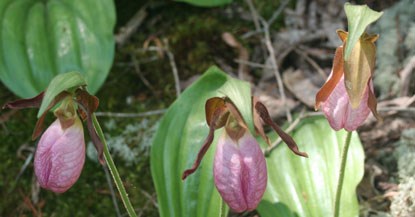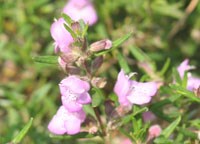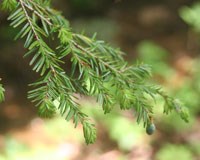
A trip through Obed Wild and Scenic River reveals a rich landscape of plants of all imaginable colors, textures, form, and function. The area's woodlands, cliff lines, stream sides, and other habitats harbor a tremendous richness of plant species. The Obed area is part of the greater southern Appalachian region, which is widely known as one of the most biologically diverse temperate forest regions in the world. While plants in Obed bear many similarities to other parts of the southern Appalachians, such as the Great Smoky Mountains, the combination of habitats and plants that occur at Obed distinguish it as a special place to explore and protect. At the heart of this landscape lies the Clear Creek and Obed gorges—a rift through the Cumberland Plateau. It is these ecological processes that helped form these gorges over thousands of years that are, in part, responsible for the area's unique plant assemblage. Within Obed's congressionally authorized boundaries, 45 miles of contiguous forested riparian and upland habitat are protected. Botanists have documented approximately 800 different plant species in the park, and this number continues to grow as new research is conducted. The park's hundreds of species include trees, shrubs, and woody vines as well as non-woody (or herbaceous) plants like spring wildflowers and wetland plants. Wetland species, unlike many terrestrial or upland plants, are actually adapted to growing in or near water. 
Floristically speaking, some areas of the park are particularly diverse, and visitors may unwittingly be walking within reach of a number of rare and unique plants. Two species worth highlighting are Cumberland rosemary (Conradina verticillata) and Virginia spiraea (Spiraea virginiana), which are both listed as federally threatened under the Endangered Species Act of 1973. In addition, the State of Tennessee lists Cumberland rosemary as threatened and Virginia spiraea as endangered. Cumberland rosemary, a riverine plant, is a small herbaceous plant in the mint family. Virginia spiraea is a perennial shrub. Surprisingly, these plants thrive in the park under relatively inhospitable conditions. Although not truly aquatic, both grow in areas where they can benefit from the scouring effect of winter's high flows, a force that limits the growth of other plants, and acts to eliminates woody competition. Eye-catching spring wildflowers like the pink lady's-slipper (Cypripedium acaule) add color to a green woodland walk, and clusters of these orchids may be found growing under forest gaps, spotlighted by late afternoon sun. A host of other wildflowers dot the forest landscape. Because many of the park's rare plants are in need of protection, it is important for visitors to stay on established trails or boardwalks to prevent impacts to the park's most sensitive species. 
Approximately 30 different forest community types are documented at the Obed Wild and Scenic River and large expanses of mostly uninterrupted forest add a primitive feel and lush backdrop to the paddler's "wild" and "scenic" river experience. Broadleaf deciduous trees (trees that shed their leaves in cold weather) and needle-leafed evergreen trees that are common to Obed forests and occur over a wide range of soil conditions from moderately moist (mesic) to zeric (dry) conditions include such species as white oak, chestnut oak, beech, various maple species, tulip tree, Eastern white pine and Virginia pine. These forests share some species and can be found growing in the park in one of two different geographic zones: the area within the gorge and along the river or the upland slopes extending above the gorge rim. Eastern hemlock (Tsuga canadensis) dominates a significant portion of the park. Roughly half of the park's approximate 5,000 acres occurs in a hemlock association of one type or another. Eastern hemlock is another cone producing tree or conifer in the pine family that is extremely vulnerable to the exotic insect pest hemlock woolly adelgid. Not all of the plants occurring in Obed forests are native to the United States, and many invasives like multiflora rose, mimosa, autumn olive, and hydrilla have the potential to outcompete native upland or aquatic plant communities. |
Last updated: April 14, 2015
